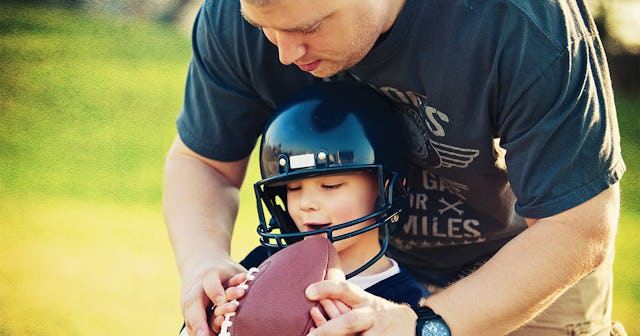Before Your Kid Plays Tackle Football, Know The Risks

In 2019, the last year we can rely on real data for youth sports, 8% of parents with children 5-18 said their kids’ sport of choice was tackle football. Considering that’s an almost-100% male sport, that’s a lot of boys playing a lot of full-contact football. And while high school participation has been falling since 2008, sometimes precipitously (in 2016-2018, says Aspen Project Play, numbers dropped by 23,311, 20,540 and 30,829), 2019 only saw a loss of 2,489 players: negligible. In all, Aspen Project Play estimates that in 2019, about 1.5 million kids from 13-17 years old played tackle football.
Lots of kids. Lots of hits.
The National Federation of State High School Associations brags that the small decrease in players from 2019 comes from parents’ increased trust. They have, they say, enacted rules in every state that limit the amount of contact allowed in both the preseason and during practice; they’ve added concussion protocols and laws. Parents, they say, “are appreciative of risk minimization efforts.”
Pop Warner Football, with over 225,000 football players from 5 to 14 years in 2019, has put strict guidelines in place to minimize injury; they claim that using their rules and their “Heads-Up Football Training” results in 87% fewer injuries. They were the first youth organization to limit contact during practices; it can’t exceed 25%. They also eliminated kickoffs for the youngest players and require a doctor’s permission for a child who has suffered a “suspected head injury” to return to play. While Pop Warner Football offers flag football teams, tackle football starts at age five.
Tackle Football Can Hurt Brains
John Giustina/Getty
Science is very, very interested in high impact exposure, concussions, and your kid’s brain. Many, many scientists have strapped many, many sensors to children’s helmets in attempts to measure impact levels, g-forces, numbers of hits, etc. One 2019 study, conducted on 29 boys ages 9-12 over three seasons, have found no correlation between “repetitive subconcussive head impacts” and “neurobehavioral functioning.”
But a 2020 study conducted over one season with 200 participants ages 9-13, who wore sensors during practices and games, found that head impact exposure had “inverse, negative relationships with cognitive change” in 9-10 year-olds. The more kids in that age group got hit, the more their brain changed for the worse.
Another 2020 study, this one published in PLOS Public Health, found that in absence of concussion, kids’ vision, hearing, and balance remained stable through two seasons of tackle football.
But that’s “in the absence of concussion.”
In 2019, The Journal of Pediatrics found a 5% concussion rate in tackle football players aged 4-15 years old. 50% returned to school in three days; the same number returned to play in 13 days. But only half had reached “a baseline of symptoms” by three weeks. Three weeks after their concussion, these kids were still exhibiting symptoms.
So The Kids Are Mostly All Right?
Not quite.
There’s a thing called “head impact burden.” That’s how often a child’s hit, and how hard, measured and summed for cumulative impact. Most studies assume that someone can tell you how often they were hit and how hard, and studies assume a “consistent impact burden from year to year.” One 2020 study found that head impact burden was higher for middle schoolers than high schoolers, and that even with middle schoolers, the head impact burden varied wildly from one season to another. Retrospectively, kids can’t accurately report how much and how hard they’ve been hit, and parents can’t accurately predict it.
Moreover, in 2019, researchers found that kids playing tackle football were intentionally using their heads to hit other players. 80% of “high-magnitude head impacts” were intentional. These impacts were not an accident. They’re built into the fabric of tackle football. Someone’s teaching kids how to do this. If 80% of these impacts are happening on purpose, it clearly comes down to something inherent in the sport, not accidentally occurring on the field.
And if your kid plays tackle football, your kid’s going to get hit: a lot. 7-8 year olds, one study found, were hit an average of 104 times per season. High school players got an average of 565 hits per season. Any way you look at it, that’s a lot.
Tackle Football’s Effect Doesn’t Stop
Thomas Barwick/Getty
Chronic traumatic encephalopathy is a degenerative brain disorder caused by, according to the CDC, “repeated traumatic brain injuries, including concussions, and repeated hits to the head, called subconcussive head impacts.” It doesn’t occur only in athletes, but athletes seem to have a higher risk. When Boston University doctors analyzed the data from the first 211 football players diagnosed with CTE, they found that starting tackle football before age 12 was associated with as much as a 13-year-earlier onset of CTE symptoms.
Obviously, organizations like Pop Warner Football have implemented safety strategies limiting contact. However, the risks of subconcussive impact remain real, and kids are still using their heads in intentional hits.
The Aspen Institute reports that 63% of parents support setting a legal age on tackle football. But when asked, NCAA officials hedge on the topic: what it would look like, what age it would start at. U.S. Soccer banned heading under age 10; they limit it to practice only from 11-13. Why would high-impact hits be okay for football players, but not soccer players?
While parents have to make their own decisions about tackle football, the risks of concussion over the course of a season remain at 5% — high for any sport — and don’t include risk of any other injuries. And while contact is limited to 25% of practice time, 7-8 year-olds are still taking over 100 hits per season. 9-10 year-olds have shown cognitive effects over the course of one season in large studies.
Tackle football might be fun, and it might be safer than before. But it still carries the same inherent risks.
This article was originally published on